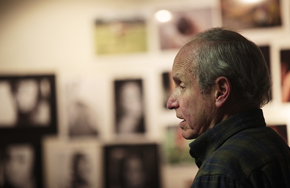Photographers Braden Chattman and Michael Zide are so in sync with one another that, during a recent talk at the Williston Northampton School, they finished each other’s sentences.

“The big word at Hallmark is ‘intention,’” said Mr. Zide. “As someone who absorbs photography,” Mr. Chattman chimed in, “that’s what ultimately matters.”
The Hallmark Institute of Photography teachers were at Williston on April 23 to give the final evening talk of this year’s Photographers’ Lecture Series. That afternoon, Mr. Chattman and Mr. Zide had also spent a class period speaking to Williston’s photography students about what a professional career in photography involves.
“Photography is a lot more than a career decision,” said Mr. Chattman. “It’s a lifestyle.” He described his dream retirement: traveling the country with his wife, who is also a photographer, in a motorcycle with a tripod mounted on its sidecar. That way there would be no glare from car windows.
“I’d be a much better driver [today] if I weren’t a photographer,” he said.
A student asked how photographers took shots from moving vehicles. The answer was a very long boom arm that attached to the roof of the car with a suction cup, Mr. Chattman explained.
A very long cable release is needed to operate the shutter from inside the car, said Mr. Zide.
The Truth in Photography
Is there any truth in a photograph, Mr. Chattman and Mr. Zide asked later that evening, with the advent of Photoshop and digital manipulation?
Mr. Zide describes himself as a traditional film photographer. He said he fell into landscape photography, which acted like a gateway drug to the medium. From the first snowfall he witnessed as a young boy in Los Angeles on January 11, 1949, he became “a collector of moments that meant wonder.”

But Mr. Zide made the point that, instead of creating a new process, Photoshop has just made manipulation easier. Since it’s inception, photography has always modified the results, he said.
Mr. Zide showed a photograph from the early 20th century where the photographer used clear strings to suspend chairs in the air. More recently, photographer William Wegman used digital manipulation to create half Weimaraner, half human portraits.
“Before photography, all of the creative arts shared a common source…imagination,” Mr. Chattman said. In all other art, an image was conceived by the artist then executed. Photography inverts that process, he said.
Mr. Chattman’s own photography uses a stitched-together style that he’s called “found-scapes,” “fake-scapes,” and “lie-scapes.” The relationship between time and truth is at the center of Mr. Chattman’s work. His specialty, he said, is “being able to build realities inside an image that are only apparent over time.”
Mr. Chattman flipped to an image of Pablo Picasso’s painted masterpiece, Guernica. “The creative arts exist to evoke a response; photographs have the advantage of being evocative, but also of bearing witness,” he said.
Mr. Picasso’s painting is just that—a reaction to the aerial bombing of the Spanish town of Guernica by German forces during the Spanish Civil War. Because he was not there, Mr. Picasso used photographs published in The New York Times as his source. So, Mr. Chattman asked, which art form is the most truthful, the painting or the photographs?
“[This painting] is a man’s interpretation of a moment in time,” he said, and therein lies the power of photography.


